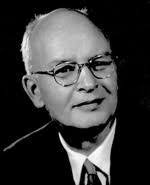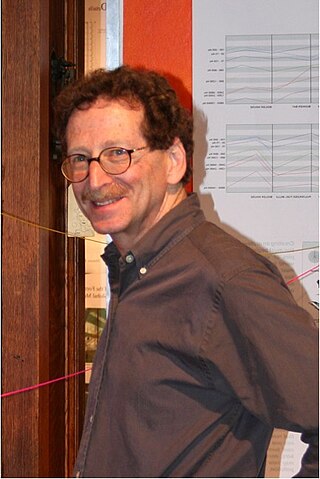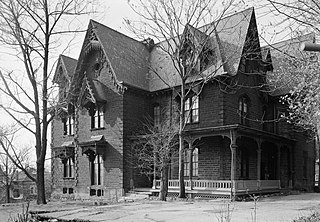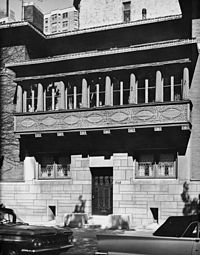
The International Style or internationalism is a major architectural style that was developed in the 1920s and 1930s and was closely related to modernism and modernist architecture. It was first defined by Museum of Modern Art curators Henry-Russell Hitchcock and Philip Johnson in 1932, based on works of architecture from the 1920s. The terms rationalist architecture and modern movement are often used interchangeably with International Style, although the former is mostly used in the English-speaking world to specifically refer to the Italian rationalism, or even the International Style that developed in Europe as a whole.
The Alice Davis Hitchcock Book Award, established in 1949, by the Society of Architectural Historians, annually recognizes "the most distinguished work of scholarship in the history of architecture published by a North American scholar." The oldest of the six different publication awards given annually by the Society, it is named after the mother of architectural historian Henry-Russell Hitchcock.

The John Deere World Headquarters is a complex of four buildings located on 1,400 acres (570 ha) of land at One John Deere Place, Moline, Illinois, United States. The complex serves as corporate headquarters for agricultural heavy equipment company John Deere.
Henry-Russell Hitchcock (1903–1987) was an American architectural historian, and for many years a professor at Smith College and New York University. His writings helped to define the characteristics of modernist architecture.

The University of Illinois School of Architecture is an academic unit within the College of Fine & Applied Arts at the University of Illinois Urbana-Champaign. The school is organized around four Program Areas - Building Performance, Detail + Fabrication, Health + Well-being, and Urbanism. Faculty teach and conduct research in these areas in support of the School's primary objective to promote critical engagement with the design of a healthy and sustainable built environment.
William J. R. Curtis is an architectural historian whose writings have focused on twentieth century architecture. Curtis seems particularly interested in broadening the "canon" to include a wider range of architects working across the world.

The American Society for Environmental History (ASEH) is a professional society for the field of environmental history. The ASEH was founded in 1977 and its mission is to increase understanding of current environmental issues by analyzing their historical background. The ASEH promotes scholarship and teaching in environmental history, supports the professional needs of its members, and connects their work with larger communities. The organization's goals are to expand the understanding of the history of human interaction with the natural world, to foster dialogue with multiple disciplines and the public, and to support global environmental history that benefits the public and scholarly communities.

Turpin Chambers Bannister was one of the leading American architectural historians of his generation. A long-time professor at the University of Illinois and the University of Florida, he is best known for his work in architectural history, including his work with The Society of Architectural Historians, and editorship of The Journal of the Society of Architectural Historians.

Andrew Scott Dolkart is a professor of Historic Preservation at the Columbia University Graduate School of Architecture, Planning and Preservation (GSAPP) and served as the Director of the school's Historic Preservation Program from 2008 to 2016.

The John F. Singer House is a house in Wilkinsburg, Pennsylvania, United States, an east-side suburb of Pittsburgh. It was built for John F. Singer, who was made wealthy during the American Civil War by supplying the Union Army with iron and steel.
The Society of Architectural Historians of Great Britain (SAHGB) is a United Kingdom learned society for people interested in the history of architecture.

Leland M. Roth is a leading American architectural historian who is the Marion Dean Ross Distinguished Professor of Architectural History emeritus in the Department of the History of Art and Architecture in the University of Oregon College of Design at the University of Oregon. His prodigious publication and teaching career began at The Ohio State University, then Northwestern University, and the University of Oregon, where he taught courses on U.S. architecture, eighteenth-century European architecture, Native American architecture, Oregon architecture, and the history of how music was performed and heard within architectural space. Roth’s studies of American and world architecture are among the most assigned and read books in university courses on the history of the built environment, and his admired work, Understanding Architecture, was translated into Spanish, Portuguese, and Turkish. Utilizing skills he acquired while completing his bachelor’s degree in architecture, Roth drafted dozens of plans, sections, and elevations for his many publications, which include Choice Reviews outstanding titles. His publications are esteemed for their unique narrative voice, and also for their assertion that style and context remain important to the scholarly discipline of architectural history. While at the University of Oregon, Roth helped create the graduate Program in Historic Preservation and taught in the annual Preservation Field School.
Emile Weil was a noted architect of New Orleans, Louisiana.
The Journal of the Society of Architectural Historians is a quarterly peer-reviewed academic journal published by the University of California Press on behalf of the Society of Architectural Historians. It was established in 1941 as the Journal of the American Society of Architectural Historians, and was renamed to its current title in the post-World War II period, around 1945. The founding editor-in-chief was Turpin Bannister. The current editor is David Karmon, a professor at Holy Cross. The journal's issues include scholarly articles on international topics in architectural history, book reviews, architectural exhibition reviews, field notes, and editorials on the relationship between the built environment, its study, and interdisciplinary topics.
Dell Thayer Upton is an architectural historian. He is emeritus professor at the department of art history at University of California, Los Angeles, and Professor Emeritus of Architecture at the University of California, Berkeley. He had taught previously at the University of Virginia.

Antoinette Forrester Downing was an American architectural historian and preservationist who wrote the standard reference work on historical houses in Rhode Island. She is credited with spearheading a movement that saved many of Providence's historic buildings from demolition in the mid 20th century and for her leadership was inducted into the Rhode Island Heritage Hall of Fame in 1978.

Francesca Ammon is an assistant professor in the City and Regional Planning and Historic Preservation departments at the University of Pennsylvania. An urban historian, she focuses on changes to the built environment over time. Recently, her work has centered around the urban renewal period in the mid-twentieth century.
Eve Blau is an American historian and scholar, who teaches at the Graduate School of Design at Harvard University as a Professor of the History and Theory of Urban Form and Design, as well as Director of Research. Blau has contributed to scholarship on the history of architecture and urban design. In 2015 she received the Victor Adler State Prize from the Austrian Ministry of Science, Research, and Economy for her work on Red Vienna and her book The Architecture of Red Vienna: 1919-1934. The Victor Adler State Prize is given for scholarship that is distinguished by its interdisciplinary breadth, use of innovative methods, contemporary historical questions, and that is widely published. In 2018, she was named Fellow of the Society of Architectural Historians and in 2022, she was inducted into the American Academy of Arts & Sciences.

Peter H. Christensen is the Arthur Satz Professor of the Humanities at the University of Rochester. He has held a Guggenheim Fellowship and is a former member of the Institute for Advanced Study.
La Luz del Oeste is a planned community on the West Side of Albuquerque, New Mexico, which is notable for its architecture and urban planning as an example of the New towns movement of the mid-20th century. The development consists of 96 townhouses along with shared community spaces and 40 acres (16 ha) of land which was left undeveloped as a viewshed toward the Rio Grande bosque and Sandia Mountains. It was designed by architect Antoine Predock in his first major commission and built between 1967 and 1974. The property was added to the New Mexico State Register of Cultural Properties in 1977 and the National Register of Historic Places in 2023.











